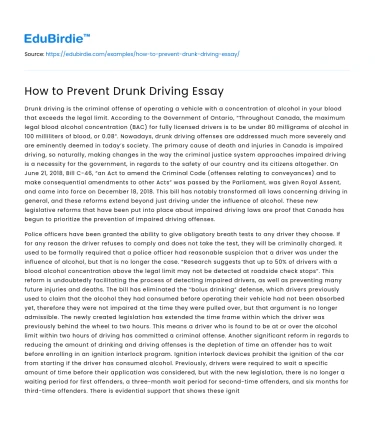Drunk driving is the criminal offense of operating a vehicle with a concentration of alcohol in your blood that exceeds the legal limit. According to the Government of Ontario, “Throughout Canada, the maximum legal blood alcohol concentration (BAC) for fully licensed drivers is to be under 80 milligrams of alcohol in 100 milliliters of blood, or 0.08”. Nowadays, drunk driving offenses are addressed much more severely and are eminently deemed in today’s society. The primary cause of death and injuries in Canada is impaired driving, so naturally, making changes in the way the criminal justice system approaches impaired driving is a necessity for the government, in regards to the safety of our country and its citizens altogether. On June 21, 2018, Bill C-46, “an Act to amend the Criminal Code (offenses relating to conveyances) and to make consequential amendments to other Acts” was passed by the Parliament, was given Royal Assent, and came into force on December 18, 2018. This bill has notably transformed all laws concerning driving in general, and these reforms extend beyond just driving under the influence of alcohol. These new legislative reforms that have been put into place about impaired driving laws are proof that Canada has begun to prioritize the prevention of impaired driving offenses.
Police officers have been granted the ability to give obligatory breath tests to any driver they choose. If for any reason the driver refuses to comply and does not take the test, they will be criminally charged. It used to be formally required that a police officer had reasonable suspicion that a driver was under the influence of alcohol, but that is no longer the case. “Research suggests that up to 50% of drivers with a blood alcohol concentration above the legal limit may not be detected at roadside check stops”. This reform is undoubtedly facilitating the process of detecting impaired drivers, as well as preventing many future injuries and deaths. The bill has eliminated the “bolus drinking” defense, which drivers previously used to claim that the alcohol they had consumed before operating their vehicle had not been absorbed yet, therefore they were not impaired at the time they were pulled over, but that argument is no longer admissible. The newly created legislation has extended the time frame within which the driver was previously behind the wheel to two hours. This means a driver who is found to be at or over the alcohol limit within two hours of driving has committed a criminal offense. Another significant reform in regards to reducing the amount of drinking and driving offenses is the depletion of time an offender has to wait before enrolling in an ignition interlock program. Ignition interlock devices prohibit the ignition of the car from starting if the driver has consumed alcohol. Previously, drivers were required to wait a specific amount of time before their application was considered, but with the new legislation, there is no longer a waiting period for first offenders, a three-month wait period for second-time offenders, and six months for third-time offenders. There is evidential support that shows these ignition interlock devices prevent offenders from reoffending, therefore reducing future drunk driving accidents.
Save your time!
We can take care of your essay
- Proper editing and formatting
- Free revision, title page, and bibliography
- Flexible prices and money-back guarantee
Canada’s newly established legislation has also made modifications to several of the offense penalties for drunk driving. Previously, a first-time offender would have to pay a minimum fine of $1000. New and improved mandatory penalties vary depending on the BAC of the first-time offender. If the blood alcohol concentration of the first-time offender was between 80-119 mg while they were operating the vehicle, the compulsory minimum fine would be $1000, a BAC of 120-159 mg would be $1500, and a BAC of 160 mg would result in a $2000 minimum fine. Another addition to the already-existing penalties is a newly mandated minimum fine of $2000 for any driver who rejects taking the mandatory breath test. The penalties for second-time and third-time offenders have remained at a minimum of 30-day incarceration and a minimum of 120-day incarceration, respectively. However, impaired driving offenses resulting in no injury or demise have been expanded to a minimum requirement of two years less a day, which had previously been 18 months, while impaired driving causing bodily harm is now considered a hybrid offense, which depending on the severity of the injuries, a summary conviction would be two years less a day, while an indictable offense would be 14 years imprisonment. The maximum penalty for any transportation offense resulting in death has been decidedly increased to life imprisonment, which had formerly been 14-year incarceration. These modifications of these penalties have without a doubt strengthened Canada’s structure and approach to impaired driving and instilled fear in drivers who regularly consume alcohol.
During the Second Reading in the House of Commons regarding Bill C-46, Hon. Jody Wilson-Raybould, Minister of Justice and Attorney General of Canada, said this: “I introduce the bill with the ultimate goal of reducing the significant number of deaths and injuries caused by impaired driving, a crime that continues to claim innocent lives and wreak havoc and devastation on Canadian families. No law is adequate comfort for devastating loss, but I want to stress that this proposed legislation was drafted with all victims of impaired driving in mind.” This quote demonstrates Canada’s awareness of the tragedies that come with drinking and driving offenses, and how these offenses must be treated with the proper amount of severity and prevented as much as possible. There is no doubt that with the enactment of these new laws and regulations, impaired driving offenses will slowly but surely begin to decrease as citizens are beginning to be made aware of the gravity of drinking and driving, and the prevention of impaired driving has been placed on a higher pedestal by the Canadian government.






 Stuck on your essay?
Stuck on your essay?

